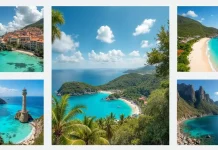The Best Time for Whale Watching in HúsavÃk, Iceland
The Unique Appeal of HúsavÃk
A Picturesque Town by the Bay
Nestled on the northern coast of Iceland, HúsavÃk is renowned for its idyllic landscape and charming small-town atmosphere. Its picturesque harbor, framed by snow-capped mountains and rugged coastline, is the gateway to some of the most rewarding whale watching experiences in the world. The town itself boasts colorful buildings, vibrant history, and a welcoming community that enhances the overall experience for travelers.
Cultural and Historical Significance
While HúsavÃk is celebrated primarily for its marine life, it also holds significant cultural and historical importance. The town is home to the HúsavÃk Whale Museum, where visitors can immerse themselves in the fascinating history of whales and whaling in Iceland. The museum offers a wealth of information on the diverse species found in the region, alongside captivating exhibits on marine biology and ocean conservation.
Whale Watching Seasons in HúsavÃk
Spring Awakening: April to May
Spring in HúsavÃk marks the beginning of the whale watching season. As the icy grip of winter loosens its hold, the bay comes alive with activity. In April and May, the waters are still quite cold, but increasing daylight and warmer temperatures start to awaken the rich marine life. This is the time when you'll witness the return of migratory species to the fertile feeding grounds.
During these months, minke whales and humpback whales often make early appearances. The food-rich waters of Skjálfandi Bay support krill and small schooling fish, drawing these giants for their seasonal feast. While not as prolific as the summer months, spring whale watching holds its own charm with the possibility of seeing playful dolphins and porpoises.
Summer Spectacle: June to August
The peak whale watching season in HúsavÃk spans from June through August, making summer the best time for whale enthusiasts. The long days of the Icelandic summer, with almost 24 hours of daylight, provide ample opportunities to head out on a boat and explore the bay. This period boasts mild weather conditions and calmer seas, enhancing the overall experience.
During summer, minke whales, humpback whales, and blue whales are at their most active. Blue whales, the largest animals on earth, are a sight to behold and are more likely to be spotted in June and early July. Humpback whales are known for their breaching and acrobatic displays, which are most frequently observed during these months. The abundance of whales, coupled with the beautiful Icelandic landscape, makes summer the most popular time for visitors.
Autumn Retreat: September to October
As the days begin to shorten in September and October, there is still plenty to see in the waters around HúsavÃk. This time of year is quieter, providing a more intimate whale watching experience with fewer tourists. While blue whales begin their migration to warmer climates, humpback whales and other species remain in the bay.
September can offer particularly excellent conditions for photography. The lower angle of the sun casts a magical light over the water, rendering each whale sighting a breathtaking moment. The northern lights begin their dance in the Icelandic sky, offering the potential for incredible evening displays.
Understanding Whale Behavior and Patterns
Migratory Patterns and Feeding Habits
Whales are migratory creatures, moving between feeding and breeding grounds throughout the year. The rich, productive waters of Skjálfandi Bay in HúsavÃk provide an ideal feeding spot during the summer months. Various species, including humpback whales, blue whales, and minke whales, converge here to take advantage of the abundant food supply.
Humpbacks are particularly known for their complex feeding techniques, such as bubble-net feeding, which can often be observed on a whale watching tour. Observing these creatures during feeding offers insight into their complex behaviors and social interactions.
Species Diversity in HúsavÃk
HúsavÃk is a prime location for observing a diverse range of whale species. From the majestic humpback to the elusive blue whale, the waters support a diversity that is unparalleled. Dolphins and porpoises are also frequently seen, adding to the variety of marine life visible from the bay.
Each species exhibits unique behaviors and characteristics, making every boat trip different from the last. The thrill of potentially sighting rare species in their natural habitat is one of the main attractions of whale watching in this region.
Planning Your Whale Watching Trip
Choosing the Right Tour Provider
A successful whale watching trip hinges on selecting the right tour provider. HúsavÃk offers several reputable companies that provide professional guides and knowledgeable crew to enhance your experience. When choosing a tour, consider their commitment to sustainability, safety records, and whether they offer tours in your preferred language.
Selecting a company that uses environmentally-friendly practices is crucial in helping preserve the local ecosystem. Providers offering smaller boats may offer more personalized experiences and greater flexibility in approach, enhancing wildlife encounters.
What to Wear and Bring
The weather in Iceland can be unpredictable, even during the summer months. Dressing in warm layers, including a waterproof jacket and sturdy footwear, will ensure you remain comfortable during your excursion. While most tour providers offer insulated overalls or rain gear, it's beneficial to be prepared.
Bringing a quality camera with a zoom lens can help you capture unforgettable moments. Binoculars can also enhance your ability to observe whales from a distance. Don’t forget to carry snacks and water; the sea air can be invigorating, leaving you hungry despite the excitement.
Making the Most of Your Experience
Patience and persistence are key on any wildlife expedition. While sightings are frequent, there’s no guarantee on timing. Listen to your guide’s explanations and insights, as they provide deeper understanding of what you’re witnessing.
Maintain an open mind and be respectful of nature. While the primary goal is to see whales, enjoy the journey, the fresh air, and the stunning Icelandic scenery. Each trip holds unique potential, promising one-of-a-kind sightings.
Environmental Considerations and Conservation
Sustainable Tourism Practices
Whale watching in HúsavÃk, like everywhere, depends significantly on the health of the local marine ecosystem. Engaging in environmentally responsible tourism is crucial to preserving whale populations and their habitat. Many local tour operators collaborate with research initiatives, offering guests the chance to contribute to conservation efforts.
Choosing a tour operator with a green policy ensures that your adventure contributes back to marine preservation. This includes adhering to strict guidelines regarding vessel distances from whales and ensuring engines run on low emissions.
The Role of Research and Education
HúsavÃk's ecosystem offers rich opportunities for scientific research and education. The interplay between tourists and researchers allows for a deeper understanding of the marine environment and the challenges it faces. Many tours are designed to incorporate educational elements, fostering awareness about conservation issues.
Researchers rely on data collected from whale watching tours, such as behavioral observations and photographic identification, to monitor populations and health conditions. By participating, visitors assist long-term conservation efforts, leaving a positive impact on the marine biodiversity of Skjálfandi Bay.
Local Attractions and Activities
Exploring Beyond the Waves
While whale watching is the main draw, HúsavÃk offers a variety of activities and attractions. From exploring the local geological wonders to relaxing in geothermal baths, there’s something for every traveler. The town is an ideal base for exploring the nearby HúsavÃk Mountains or taking day trips to other iconic sites in North Iceland.
For those interested in history, a visit to the HúsavÃk Exploration Museum is a must. It highlights the astounding feats of explorers, providing insights into Iceland’s role in global explorations and the Apollo program.
Culinary Delights in HúsavÃk
Experiencing the flavors of Iceland is an essential part of any visit. Local restaurants in HúsavÃk offer a range of traditional Icelandic dishes and international cuisine. Seafood is, unsurprisingly, a highlight, with freshly-caught fish and langoustines frequently featured on menus.
For an authentic taste, try the local specialty, plokkfiskur, a comfort dish made from mashed fish and potatoes. Enjoying a meal after a day on the water rounds off the experience, offering time to reflect on the day's sightings and relax in welcoming surroundings.
Capturing HúsavÃk in Popular Culture
The Impact of Film and Media
HúsavÃk gained international attention with the release of the 2020 film “Eurovision Song Contest: The Story of Fire Saga,” which features the town as a central setting. The film’s humorous portrayal of the Eurovision contest brought HúsavÃk's scenic beauty to a global audience.
This exposure increased interest in the town, drawing Eurovision fans and travelers alike. Many visitor experiences can be enriched by discovering locations featured in the film, adding a layer of pop-culture significance to the natural wonders.
Participating in Local Festivals
Throughout the year, HúsavÃk hosts various local festivals that add vibrancy and cultural depth to a visit. The Mærudagar festival in early July celebrates local music, art, and community spirit with parades and concerts. Engaging with the local community during these times provides further insight into the spirit and traditions of the area.
In conclusion, HúsavÃk offers a breathtaking combination of natural beauty, exceptional whale watching opportunities, and a chance to engage with Icelandic culture. Whether you visit in the spring, summer, or fall, every trip is sure to create lasting memories.




























